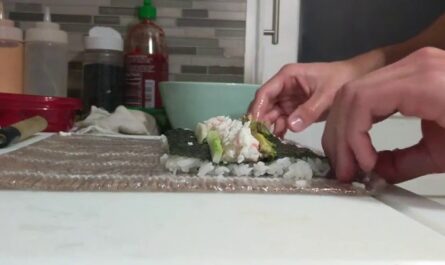Bamboo mats are an essential tool for any sushi lover or anyone enthusiastic about making sushi at home. With the right care, these mats can last a long time and provide excellent service. However, one of the most common issues people face with bamboo mats is the development of mold.
To ensure your bamboo mats remain mold-free, it’s crucial to know what causes mold and how to prevent it. In this article, we will delve into the necessary steps for avoiding mold on bamboo mats to help you keep them in pristine condition.

Understanding Mold Growth on Bamboo Mats
Mold is a type of fungus that thrives in warm, damp environments. Bamboo mats can become the perfect breeding ground for mold if they are not cared for properly.
When bamboo mats are exposed to moisture and humidity without proper drying, the risk of mold growth increases significantly. Therefore, understanding the causes can help you take proactive measures to keep your sushi-making tools clean and healthy.
Why Mold Forms on Bamboo Mats
Mold forms on bamboo mats primarily due to two main reasons: moisture and lack of ventilation. Often, after washing, bamboo mats are left damp or not dried properly, creating ideal conditions for mold.
Also, storing mats in an area with poor ventilation can trap moisture, further exacerbating the problem. Hence, it’s essential to know how to address these factors.
Preventing Mold on Bamboo Mats
Preventing mold requires a consistent regimen of proper cleaning and storage techniques. By adopting these practices, you can extend the life of your bamboo mats significantly.
Easy Cleaning Techniques
Regularly cleaning bamboo mats is the first step in preventing mold. After each use, rinse the mat thoroughly with warm water to remove all food residue.
For a deeper clean, use a small amount of mild detergent. Ensure all soap is rinsed away since any remaining residue can attract moisture.
Perfect Drying Methods
Drying is arguably the most critical step in avoiding mold. After washing, shake off the excess water and leave the mat in a well-ventilated area. Ideally, hang the mat to allow both sides to dry properly.
Do not store the mat until it is entirely dry. A quick way to achieve proper drying is to use a fan or a hairdryer on a low setting for a few minutes.
Storage Tips to Prevent Moisture Accumulation
Proper storage is crucial in the fight against mold. Ensure your bamboo mats are stored in a cool, dry place with good airflow.
Avoid storing them in plastic bags or sealed containers, as these trap moisture and can encourage mold growth.
Signs of Moldy Bamboo Mats
Spotting mold early is essential to maintaining the hygiene of your sushi-making process. Regularly inspect your bamboo mat for any signs of discoloration or a musty smell.
If you notice any mold, it’s crucial to address the issue promptly to prevent it from spreading and damaging your tools.
Discolored Bamboo Mats
Mold often appears as black, green, or white spots that are slightly fuzzy. These will generally spread over time, not just on the surface but also in the crevices of the mat.
Unpleasant Odor
A musty smell is a sure sign of mold presence. If your bamboo mat emits an unusual odor, consider treating or replacing it.
Treating Moldy Bamboo Mats
Once mold sets in, quick action is necessary. While some cases might be salvageable, severe mold growth often requires replacing the mat.
Cleansing with Vinegar Solution
A mixture of vinegar and water can effectively kill mold. Soak the mat in a solution of one part vinegar to four parts water for about 30 minutes.
Afterward, scrub gently with a brush, rinse thoroughly, and dry the mat completely before storing it.
Baking Soda for Mold Removal
Baking soda is another excellent mold treatment. Sprinkle baking soda over the affected areas, let it sit for a few minutes, then use a brush to scrub away the mold.
Rinse and dry the mat properly after treatment.
Regular Maintenance Routine
Incorporating a regular maintenance routine can save you a lot of trouble in the future. Besides cleaning and drying your mats after each use, consider scheduling monthly checks.
Routine Checks
During these checks, inspect your bamboo mats for any signs of wear or mold growth. This habit will help detect issues early before they become significant problems.
Professional Cleaning Options
For those who frequently use their bamboo mats, it might be worthwhile to consider professional cleaning options to ensure their longevity.

Frequently Asked Questions
Can I use bleach to clean mold off bamboo mats?
It’s generally not recommended to use bleach on bamboo mats as it can degrade the material. Natural cleaning solutions like vinegar or baking soda are preferred.
Do bamboo mats require any special treatment for storage?
For optimal care, store your bamboo mats in a cool, dry place with good air circulation to prevent moisture accumulation.
Are there any alternatives to bamboo mats?
Although bamboo mats are traditional, some people also use plastic wrap [with sushi](https://sushiandrice.com/can-you-make-sushi-with-plastic-wrap/ ‘making sushi with plastic wrap’) as an alternative. For more insights into using different mat types, check out our [traditional Japanese sushi equipment](https://sushiandrice.com/traditional-japanese-sushi-equipment/ ‘equipment for sushi making’).
This article contains affiliate links. We may earn a commission at no extra cost to you.




